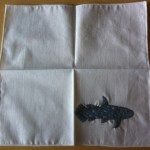
 Hans Fricke may not be a familiar name to you. His voice was never auto tuned into a pop hit, he did not make a list of the top ten running backs of all time, and you will not see his fashion collection in Milan. No his contributions to society are greater.
Hans Fricke may not be a familiar name to you. His voice was never auto tuned into a pop hit, he did not make a list of the top ten running backs of all time, and you will not see his fashion collection in Milan. No his contributions to society are greater.
Fricke has spent over 40 years accumulating and searching for one of the Earth’s rarest fish, the coelacanth. Since 1986, he has lead more than 400 submersible dives to discover the secret lives of this mysterious fish. In his late sixties, when most would retire, Hans Fricke was using a remote operated vehicle to study the largest known aggregation of coelacanths off Grand Comore, a tiny island sandwiched between the African coast and the northwestern tip of Madagascar. At age 70, Hans reveals in a recent scientific publication his lessons from 25 years of diving with an elusive and relic sea creature. We would know considerably little about the coelacanth without Fricke.

Three years before Hans was born, a fishing trawler off South African landed a fish unrecognizable to the captain and crew. The fish was shown to Marjorie Courtney-Latimer, a curator at the South African East London Museum. She believed, after rifling through many books, the fish to resemble prehistoric specimens known only from oceans existing 60-100 million year ago. Courtney-Latimer sent a crude drawing and a written description to Professor J.L.B. Smith, a local chemistry professor with an obsession for African fishes. The story takes a well-known turn in which Smith finally cables back to Courtney-Latimer “IMPORTANT PRESERVE SKELETON AND GILLS = FISH DESCRIBED” only after she had the fished taxidermied. Then there is the subsequent 13 years for Smith to see another specimen. Despite this the coelacanth was described scientifically in 1939 as Latimeria chalumnae after Marjorie and the site where the specimen was caught, off the mouth of the Chalumna River.
Years later we know that the specimen likely came from the waters of the Comores Islands and likely swept down to South Africa by the strong Mozambique current. Local Comoran fishermen had caught coelcanths for some time, throwing them back because of the fish’s foul taste due to high urea and oil concentrations. The fishermen refer to them as gombessa or taboo. Off these same islands, Hans Fricke has worked to shed light on this taboo from the dark depths.
The Comores Island’s coelacanths are the best known. Although the coelacanth may be widespread, other sightings in Sri Lanka, India, Seychelles, and South American are anecdotal at best. Recently three coelacanths were filmed near submarine caves off South Africa extending the range of the coelacanth down the African coast.
But there is more than one type of coelacanth. In 1999, a new species of coelacanth was given the name Latimeria menadoensis. 10,000 kilometers from the Comores population, the Indonesian coelacanth is genetically and morphologically distinct.
From Comores populations, we know that adults prefer topographically complex areas. Unlike Osama Bin Laden, coelacanths can actually be found in caves. Coelcanths are the night walkers, avoiding venturing out during the daylight. They rarely venture far from a home series of caves and within this home area may reside in multiple caves. There exist a “local knowledge” of preferred caves. Many suitable caves in the home area often go inhabited.
Fricke and others have determined that the coelacanth is a fish of records. The daily food intake and metabolic demands of this fish are the lowest among all vertebrates. The formation and development of the coelacanth embryo extends for three years, the longest of any vertebrate. At birth, juveniles already measure 35 centimeters in length.
To date, only eight juvenile specimens are known. In the 21 years of studying the Comores populations no juveniles or subadults were ever seen. Where juveniles go and what they do is unknown. The observations of Fricke’s team are limited completely to adults, often greater than one meter in length. As adults, the female coelacanth will be much larger than her male counterpart. Males will measure 1.2-1.3 meters in length while females reach lengths of 1.6 to 1.8 meters. Female bodies will also be broader and deeper than males.

Over the lifespan of a coelacanth, possible reaching over a century, there is little risk of mortality. Indeed, coelacanths possess one of the lowest natural death rates of any vertebrate. No natural predators of the coelacanth are known. The only real predator of the coelacanths is local fishermen. They accidentally catch coelacanths with hook and longline during their nocturnal fishing for the oilfish. But the number of coelocanths taking yearly is a meager four in the Comores population although Tanzanian fisheries may reach up to 13 annually. Recruitment into the population of new coelacanths is extremely low but enough to match that of those dying so that the population does not fade.
The exception to the typically low death rates was seen in 1994. In this year the number in Comores population dropped by 32%. In this same year, Fricke also noted that the temperature of the deep water was the highest he had measured. Because of their respiratory and metabolic demands, coelacanths must avoid warm water.
The colecanth was once revered for being a living fossil. A term we use for living species that appear to be the same as species only known from fossils and with no close living relatives. This fish with lobed fins was reminder of times when a similar lobed fin gilled ancestor was an evolutionary step to walking tetrapods. Indeed, we once thought the coelacanth walked along the ocean floor with its lobed fins. But Fricke’s detailed observations proved to provide a far more interesting story. Fricke observed the fish actually swimming through the water column (see videos here), but moving its fins in an alternating pattern similar to that of a four-legged animals.
Perhaps the mystery and taboo of coelacanth resides in that the fish is a rarity in modern oceans and a relic of the past. Enigmatic is the word Han’s uses in his publication. Although Han’s work has gone far to reveal the secret life of the coelacanth, it remains no less mystifying or intriguing.
Fricke, H., Hissmann, K., Froese, R., Schauer, J., Plante, R., & Fricke, S. (2011). The population biology of the living coelacanth studied over 21 years Marine Biology DOI: 10.1007/s00227-011-1667-x






Nice story! So when can I get one for my reef tank?
yes,I have to thank the Deep-Sea News specially the editor of this column for making my homeland known by the others who never have the opportunity to visit my beautiful country from this special fish, also something special that my National football team brings this fish’s name ( coelacanth ) many thanks